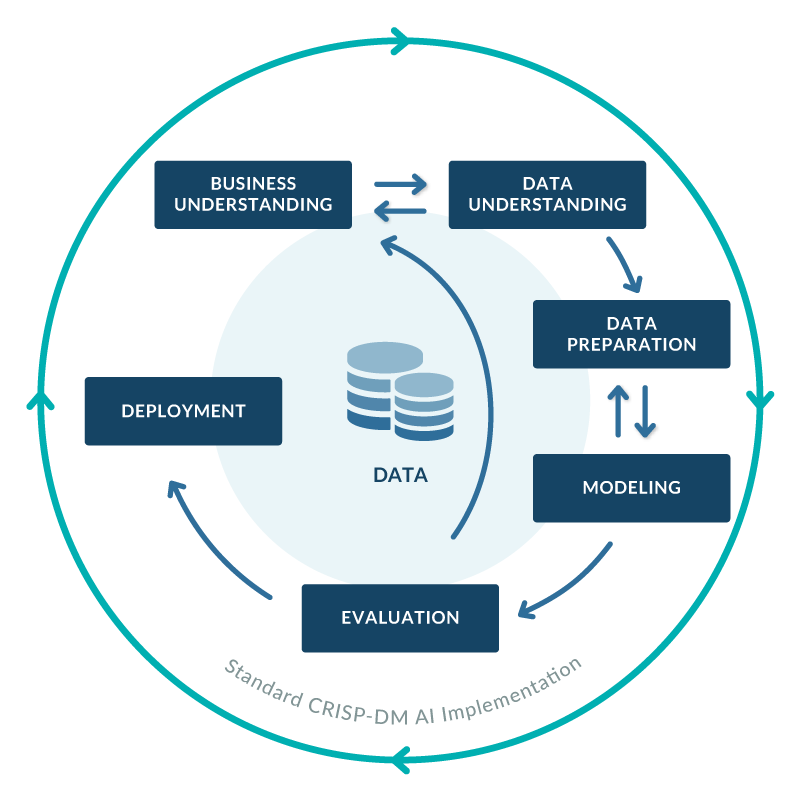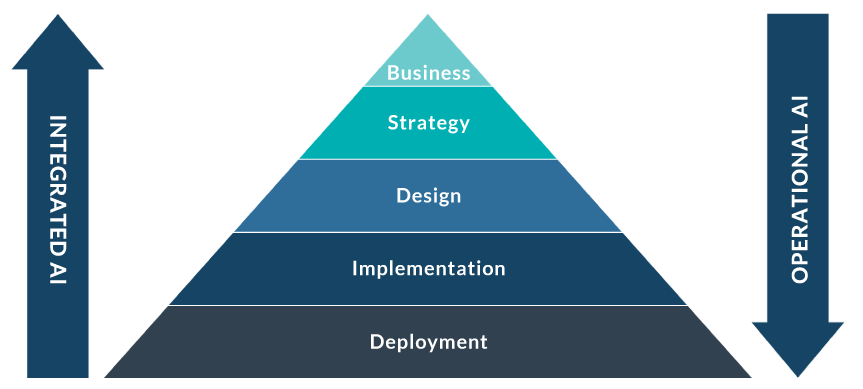
04 Aug 2021 Deploy Successful AI Projects with Integrated and Operational AI
Before going into the core reasoning behind the use of integrated and operational AI, I’d like to take a few steps back in time and return to the notion of the first industrial revolution in the second half of the 18th century and the beginning of the 19th.
The beauty of that revolution was not that it was innovative: everybody knew how to make things out of iron, and everybody knew the mechanics of manufacturing finished products from raw materials. The ingenuity of that period was in the scale of operations, and this is something I would like to emphasise.
When a new cool technology comes to market it initially has a wow factor, known as the hype cycle, but once this cycle is over the focus is on the operational aspect, to implement it practically and scale it out as quickly as possible. If not, the technology’s potential is lost, and it’s this lesson that we will focus on in this article.
Another aspect of data science or Machine Learning (ML) projects to bear in mind is that almost 87% of them never make it to production, according to a 2019 VentureBeat article. The same article mentions that the top 3 reasons for data science project failure are a lack of leadership support, the fact that data in a lot of organisations is highly scattered (fragmented and not standardised), and a lack of collaboration.
Now, what is operational and integrated AI? Before we go into this, we first need to understand the different operations in an AI implementation lifecycle. In a standard Cross-Industry Standard Process for Data Mining (CRISP-DM) AI implementation for a customer’s AI or data science project, there are generally common tasks like data wrangling, feature engineering, statistical tests, building models, then validating and tuning them; as shown in the figure below.

Of course, the more experiments you conduct, the more chance of finding the next big thing. But you can’t just wait for the perfect experiment, so you need to exploit as much information as possible from the experiment that you’re conducting. The key is the balance between experimentation and exploitation.
1. Operational AI
The next big question to delve into is what operational AI is. There are many different opinions and answers, but based on my understanding and experience, operational AI is a synchronised combination of a platform, a process, and a framework; which helps organisations to build, govern and structure AI implementations to scale in a secure manner.
The platform must be aligned to the needs of your organisation; you’ll need a process that is going to help you to govern the implementations, and lastly, you’ll need a framework that gives you structure. Any company department that starts an AI project needs to follow that framework strictly, so that all the projects in the organisation have a standard structure. If projects are built upon a single platform, they are easier to manage, operate and maintain.
The process is key too, considering the importance given to data privacy, bias, and model fairness: these are topics of concern for major corporates. So what we need is a process that can govern all these areas through a proven platform and framework, whilst doing it to scale and securely. This is what operational AI is, regardless of what technology, tool or platform you choose – there are no wrong choices here. The best choice is what’s right for your organisation, as every organisation has their own values and strategies to build on. This is a crucial point that I cannot overemphasise.
A lot of company executives might think that this type of operation represents a massive change, but it really doesn’t. These are standard practices that are actually being carried out in all your other software deliveries. Just as in a software implementation project there is a standard platform to build upon, there’s also a standard governance policy and a standard framework to which your projects have been built. We need to achieve the same break-down of AI projects.
2. Integrated AI
Integrated AI means that business applications and processes are directly integrated with AI insights and information at the right point in time for decision-making. This is the added value, because at the end of the day, what AI is helping you to do is to make better data-driven decisions.
In the past, we used to take decisions based on Business Intelligence KPIs or certain descriptive KPIs from our data, but now we are going to use information with a predictive capacity too. Integrated AI, simply put, gives you the information you need for decision-making – it is AI in the right form, in the right place, and at the right time.
The information generated by your AI model needs to be converted for business consumption, but it doesn’t end there – you need it in the right place, at the right time. Let’s imagine you’re a telecom company trying to understand the churn risk of a particular customer. The churn risk probability of that customer has to be pushed towards the call-centre dashboard where your call-centre executive is actually receiving the call from that customer, at the time when that call is received. Information has to be integrated to the right place and available at the right time, at the point of decision-making; integrated AI is all about merging this together.

3. Deploying A Successful AI Project With Integrated & Operational AI
Now let’s take a look at integrated and operational AI together. Operational AI and integrated AI are, in a certain sense, opposites. Operational AI is something that the business needs to think about, so it’s a top-down approach. Management and above need to understand what their specific business challenges are.
Integrated AI is something from the bottom up, looking at much smaller segments of the challenge, only focusing on the integration side of things – maybe instead of Python, it’s better to use C ++ or Java, because based on the application that it’s going to integrate with, it might give a much better result.
So when we combine the two, it means that whoever is doing this integration needs to keep the final goal in mind – it’s being built for a particular design or strategy of a particular business group. And the business needs to ensure that siloes are removed and operations flow smoothly at all levels of the project. What does this look like in practice if you want to deploy a successful AI project?
Business leaders first need to understand that three things have to be in place: the platform, the process, and the framework; and of course, a certain amount of capital is required for the platform and the skill. Remember that there’s a certain amount of experimentation culture embedded in AI and ML, so it’s not as agile as other software development cycles, and some patience is required.
A proper roadmap and strategy governance policy are also key to the successful deployment of an AI project. You need to understand the challenges that you would like to solve in your business and structure the roadmap with clearly identified priorities; then you need to break that down into smaller business problems, always focusing on your KPIs.
Obviously, your business needs to have a solid data engineering team, and this is where most of your office expenses are going to go. A centralised data lake or proper data warehouses for different departments in the form of data marts, all taking data from that central data lake, is something that all organisations should strive towards.
The fifth and final element is software engineering prowess, which is important because AI integrations are going to happen in all layers, either through dashboards and reports or integrated directly with the applications.
How To Get Started?
Having understood these five essential aspects of a successful AI implementation, how do you get started? ClearPeaks has developed a generalised AI project process for businesses: first, the discovery/advisory phase to understand what challenges the business is facing and secondly, whether AI is applicable in this area – just because something is cool, that doesn’t mean that it can solve all your problems. Mathematical optimisation and other heuristic processes can resolve lots of different business challenges, often giving better results than AI in terms applicability as well as cost efficiency.
Once we’ve identified some business challenges, the next step is gap analysis, where we look at what you’ve got, where you want to go, and the gap between these two in terms of data, process, and operational points that need to be integrated together.
The next step is extremely important: choosing the right platform, which in most projects will determine the turnaround time. Once you’ve chosen the right platform, you can devise or scope out your MVP, the minimum viable product. And now, with this approach, we have something that is operational, integrated with the business challenges that you’re trying to solve; and once it’s proven, it’s time to scale up. Just repeat this exercise for any use case that you have, and you’re good to go!
Here at ClearPeaks, our experts are familiar with the challenging business landscape and the complex aspects of day-to-day operations. Now that you’ve seen the steps to follow in an AI deployment, don’t hesitate to contact us if you have any AI/ML projects in your pipeline – we’ll be happy to share our expertise with you on a successful AI journey.


